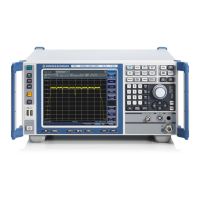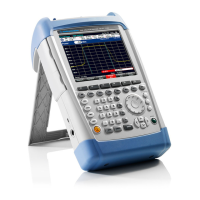Quick Start
R&S
®
FSVA/FSV
90Operating Manual 1176.7510.02 ─ 09
●
Measuring Channel Power and Adjacent Channel Power
For a more detailed description of the basic operating steps, e.g. selecting menus and
setting parameters, refer to Chapter 2.4, "Basic Operations", on page 61.
2.5.1 Measuring a Sinusoidal Signal
One of the most common measurement tasks that can be handled by using a signal
analyzer is determining the level and frequency of a signal. When measuring an
unknown signal, you can usually start with the presettings.
High input values
If levels higher than +30 dBm (=1 W) are expected or are possible, a power attenuator
must be inserted before the RF input of the analyzer. If this is not done, signal levels
exceeding 30 dBm can damage the RF attenuator or the input mixer. The total power
of all occuring signals must be taken into account.
Test setup
●
Connect the RF output of the signal generator to the RF input of R&S FSVA/FSV.
Table 2-4: Signal generator settings (e.g. R&S SMU)
Frequency 128 MHz
Level -30 dBm
2.5.1.1 Measuring the Level and Frequency Using Markers
The level and frequency of a sinusoidal signal can be measured easily by using the
marker function. The R&S FSVA/FSV always displays its amplitude and frequency at
the marker position. The frequency measurement uncertainty is determined by the fre-
quency reference of the R&S FSVA/FSV, the resolution of the marker frequency dis-
play and the number of sweep points.
1. Reset the instrument by pressing the PRESET key.
2. Connect the signal to be measured to the RF INPUT analyzer input on the instru-
ment front panel.
3. Set the center frequency to 128 MHz.
a) Press the FREQ key.
The dialog box for the center frequency is displayed.
b) In the dialog box, enter 128 using the numeric keypad and confirm the entry
with the MHz key.
4. Reduce the frequency span to 1 MHz.
a) Press the SPAN key.
Basic Measurement Examples

